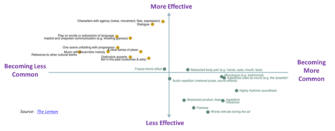Is Your Fundraising and Advertising Reformation or Renaissance?
The last 15-20 years have seen a stunning decline in advertising effectiveness. Less effective ads are becoming more common. Copy-catting is one thing, copy-catting bad ideas is quite another. The traits of good advertising matter in video and static ads (print or digital) but also, copy. Some decree this mirrors culture and there’s historical precedent.

Art – of which advertising is a form – reflects culture. For example, Renaissance art was drastically different from Reformation art. The former was Da Vinci, Michelangelo and Donatello. It was more vivid, rich, less rigid and more realistic (or today’s less useful, obtuse word, authentic).
There were more characters and settings. Reformation art was much more constrained and rigid, less realistic, often portraying religious figures with less dimensionality (e.g. foreground and background).
Art reflected culture. Some would argue we’re at the cusp of or perhaps living through another Reformation of sorts and hence, crappy advertising is merely reflecting present values and mores – more rigid, more abstract, more strict adherence to new norms, less realistic.
Ours is not to wade into this largely academic discussion that quickly reduces to mindless political debate if you pull the string hard enough. Instead, ours is to zig when others zag if there is clear, compelling evidence the crowd no longer has the wisdom. We’re there.
Hallmarks of bad advertising/writing:
- Abstract
- Superimposing words over images (video or still)
- Mindless repetition
- Adjectives (especially those used as nouns that add to abstraction or what we’d call the Bullshit factor – e.g. the “possible”)
- Parts of people (literally just hands or eyes or faces) instead of whole people
- Voiceovers
- Rhythmic soundtracks
Hallmarks of good advertising/writing:
- Characters you bring to life with agency and voice and movement
- Characters with dialogue
- A real setting, not contrived or abstracted
- A progression (bad situation and circumstance leads to intervention and positive, agentic change i.e. our redemption story arc)
- Set in the past and brought forward
- Implicit and unspoken communication (video)
- Melody in soundtrack
- Show, don’t tell (written word). Which you do you prefer?
- I walked through the forest. It was already Fall and I was getting cold OR
- The dry orange leaves crunched under my feet as I pulled the collar up on my coat.
Kevin


